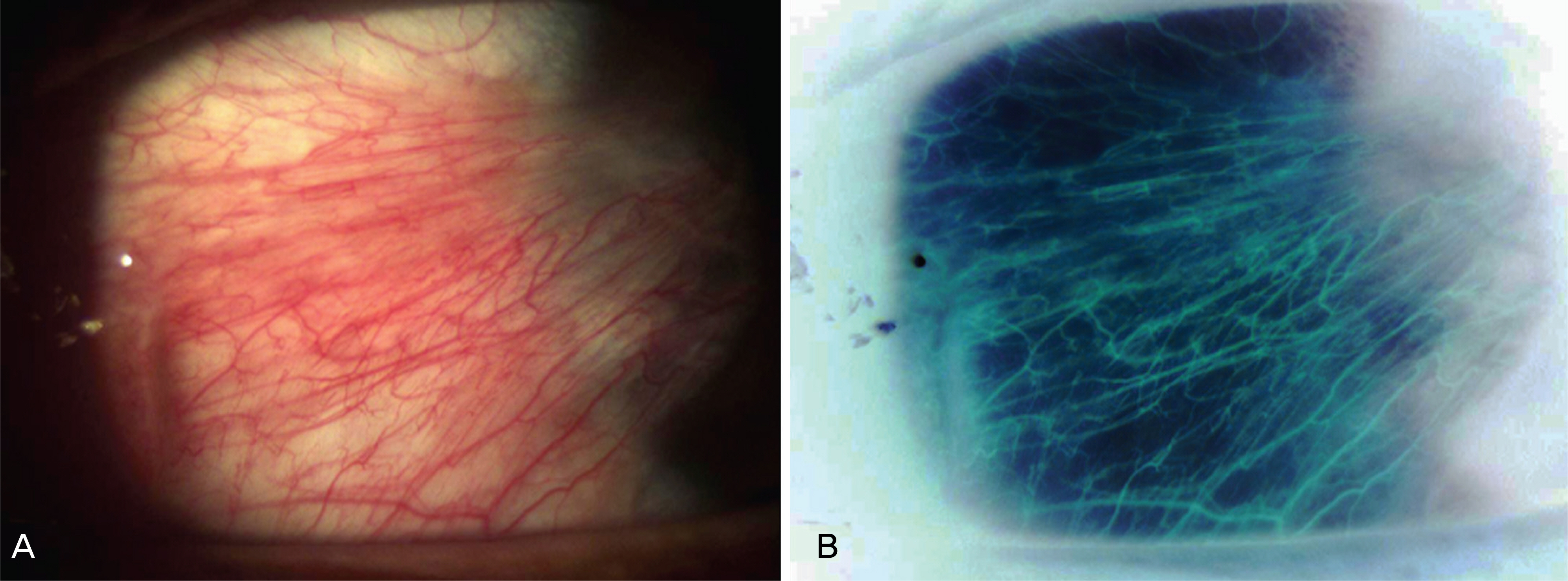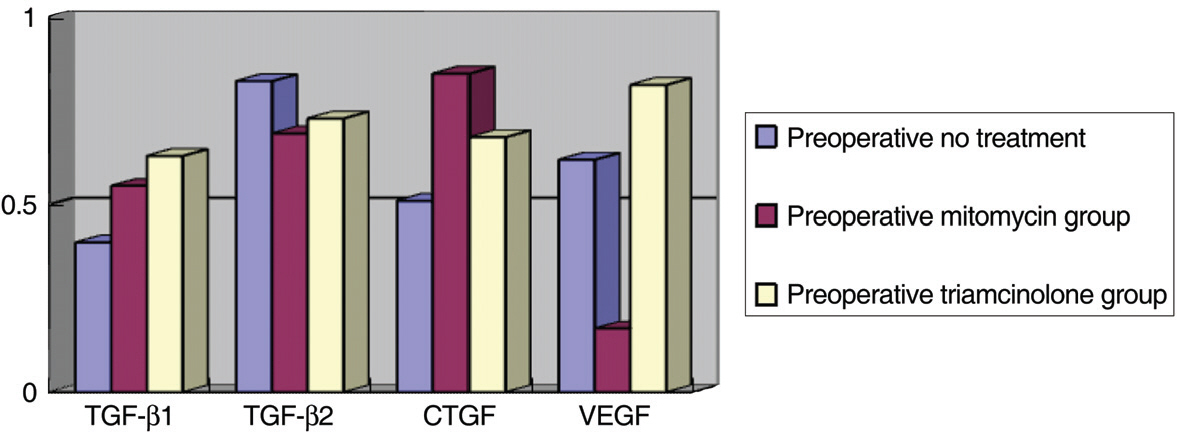J Korean Ophthalmol Soc.
2009 Jul;50(7):1005-1014. 10.3341/jkos.2009.50.7.1005.
The Effect of Preoperative Subconjunctival Injection of Mitomycin C and Triamcinolone in Recurrent Pterygium
- Affiliations
-
- 1Department of Ophthalmology, Kyungpook National University, School of Medicine, Daegu, Korea. okeye@hanmir.com
- KMID: 2212487
- DOI: http://doi.org/10.3341/jkos.2009.50.7.1005
Abstract
- PURPOSE
To evaluate the effect of a preoperative subconjunctival injection of mitomycin C or triamcinolone in patients with recurrent pterygium. METHODS: The records of 50 eyes of 50 patients who received excision of recurrent pterygium between June 2006 and January 2007 were reviewed. The recurrence rate and postoperative fibrovascular growth were compared in the preoperative subconjunctival mitomycin C, or triamcinolone injection group and non-treated control group. Additionally, the quantitative expression level of the transforming growth factor-beta1, -beta2 (TGF-beta1, -beta2), connective tissue growth factor (CTGF), and vascular endothelial growth factor (VEGF) in excised sample of the pterygium was assessed. RESULTS: There was no statistically significant difference in the recurrence rate and the relative gene expression level of growth factors in the triamcinolone group and the mitomycin group when compared with the non-treated control group. Postoperative fibrovascular proliferation was more severe in the triamcinolone group than other groups. CONCLUSIONS: Subconjunctival mitomycin C or triamcinolone as adjunctive therapy before pterygium excision did not influence the recurrence rate of pterygium.
MeSH Terms
-
Connective Tissue Growth Factor
Eye
Gene Expression
Humans
Intercellular Signaling Peptides and Proteins
Mitomycin
Pterygium
Recurrence
Triamcinolone
Vascular Endothelial Growth Factor A
Connective Tissue Growth Factor
Intercellular Signaling Peptides and Proteins
Mitomycin
Triamcinolone
Vascular Endothelial Growth Factor A
Figure
Cited by 1 articles
-
Autophagy of Human Tenon's Capsule Fibroblasts Induced by Mitomycin-C
Channy Park, Raekil Park, Seong Kwang Ryu, Dong Wook Lee
J Korean Ophthalmol Soc. 2011;52(11):1337-1343. doi: 10.3341/jkos.2011.52.11.1337.
Reference
-
References
1. Sanchez-Thorin JC, Rocha G, Yelin JB. Meta-analysis on the recurrence rates after bare sclera resection with and without mitomycin C use and conjunctival autograft placement in surgery for primary pterygium. Br J Ophthalmol. 1998; 82:661–5.
Article2. Oh TH, Choi KY, Yoon BJ. The effect of conjunctival autograft for recurrent pterygium. J Korean Ophthalmol Soc. 1994; 35:1335–9.3. Prabhasawat P, Barton K, Burkett G, Tseng SC. Comparison of counjunctival autografts, amniotic membrane grafts and primary closure for pterygium excision. Ophthalmology. 1997; 104:974–85.4. Kria L, Ohira A, Amemiya T. Immunohistochemical localization of basic fibroblast growth factor, platelet derived growth factor, transforming growth factor-beta and tumor necrosis factor-alpha in the pterygium. Acta Histochem. 1996; 98:195–201.5. Lee DH, Cho HJ, Kim JT, et al. Expression of vascular endothelial growth factor and inducible nitric oxide synthase in pterygia. Cornea. 2001; 20:738–42.
Article6. Van Setten G, Aspiotis M, Blalock TD, et al. Connentive tissue growth factor in pterygium: simultaneous presence with vascular endothelial growth factor – possible contributing factor to connjunc-tival scarring. Graefes Arch Clin Exp Ophthalmol. 2003; 241:135–9.7. De Keizer RJ. Pterygium excision with or without postoperative irradiation, a double-blind study. Doc Ophthalmol. 1982; 52:309–15.
Article8. Alanuz-Camino F. The use of postoperative beta radiation in the treatment of pterygia. Ophthalmic Surg. 1982; 13:1022–5.9. Donnefeld ED, Perry HD, Fromer S, et al. Subconjunctival mitomycin C as adjunctive therapy before pterygium excision. Ophthalmology. 2003; 110:1012–6.
Article10. Cano-Parra J, Diaz-Llopis M, Maldonado MJ, et al. Prospective trial of intraoperative mitomycin C in the treatment of primary pterygium. Br J Ophthalmol. 1995; 79:439–41.
Article11. Cardillo JA, Alves MR, Ambrosio LE, et al. Single intraoperative application versus postoperative mitomycin C eye drops in pterygium surgery. Ophthalmology. 1995; 102:1949–52.
Article12. Panda A, Das GK, Tuli SW, Kumar A. Randomized trial of intraoperative mitomycin C in surgery for pterygium. Am J Ophthalmol. 1998; 125:59–63.
Article13. Oguz H, Basar E, Gurler B. Intaoperative application versus postoperative mitomycin C eye drops in pterygium surgery. Acta Ophthalmol Scand. 1999; 77:147–50.14. Singh G, Wilson MR, Foster CS. Long-term follow-up studyof mitomycin eye drops as adjunctive treatment of pterygia and its comparison with conjunctival autograft transplantation. Cornea. 1990; 9:331–4.15. Hayasaka S, Noda S, Yamanoto Y, Setogawa T. Postoperative instillation of low-dose mitomycin C in the treatment of primary pterygium. Am J Ophthalmol. 1988; 106:715–8.
Article16. Chen PP, Ariyasu RG, Kaza V, et al. A randomized trial comparing mitomycin C and conjunctival autograft after excision of primary pterygium. Am J Ophthalmol. 1995; 120:151–60.
Article17. Ma DH, See LC, Liau SB, Tsai RJ. Amniotic membrane graft for primary pterygium: comparison with conjunctival autograft and topical mitomycin C treatment. Br J Ophthalmol. 2000; 84:973–8.
Article18. Prabhasawat P, Tesavubul N, Leelapatranura K, Phonjan T. Efficacy of subconjunctival 5-fluorouracil and triamcinolone injection in impending recurrent pterygium. Ophthalmology. 2006; 113:1102–9.
Article19. Tan DT, Chee SP, Dear KB, Lim AS. Effect of pterygium morphology on pterygium recurrence in a controlled trial comparing conjunctival autografting with bare sclera excision. Arch Ophthalmol. 1997; 115:1235–40.
Article20. Donnenfeld ED, Perry HD, Fromer S, et al. Subconjunctival mitomycin C as adjunctive therapy before pterygium excision. Ophthalmology. 2003; 110:1012–6.
Article21. Chen CW, Huang HT, Bair JS, Lee CC. Trabeculectomy with simultaneous topical application of mitomycin C in refractory glaucoma. J Ocul Pharmacol. 1990; 6:175–82.22. Govinden R, Bhoola KD. Genealogy, expressin, and cellular function of transforming growth factor-beta. Pharmacol Therap. 2003; 98:257–65.23. Nakamura K, Kurosaka D, Yoshino M, et al. Injured corneal epithelial cells promote myodifferentiation of corneal fibroblasts. Invst Ophthalmol Vis Sci. 2002; 43:2603–8.
- Full Text Links
- Actions
-
Cited
- CITED
-
- Close
- Share
- Similar articles
-
- Clinical Results After Application of Bevacizumab in Recurrent Pterygium
- The Comparative Assessment of Filtering Bleb by Timing of subconjunctival Injection of Mitomycin-C in Glaucoma Filtering Surgery
- Effect of Combined Therapy of Mitomycin C with Beta Irradiation for Prevention of Recurrence of Primary and Recurrent Pterygium
- The Effect of Subconjunctival Bevacizumab Injection after Primary Pterygium Surgery
- Conjunctival Necrosis following Ahmed Valve Implantation and Subtenon Triamcinolone Injection





